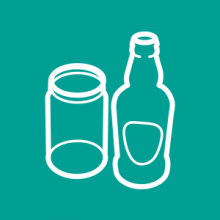Glass
Glass is recycled widely in places around the UK, with kerbside collections and some 50,000 bottle banks dotted around the country capturing the 752,000 tonnes of glass that are recycled annually. Glass waste is significant, with families in the UK using around 330 glass bottles and jars a year.
The great thing about glass is that it can be recycled infinitely without losing its quality, while using recycled glass in the glass-making process actually reduces energy consumption.
The glass recycling process involves melting the glass and cutting it into the desired shape. Recycling glass produces environmental benefits, with the energy saved by recycling one glass bottle enough to power a TV for 20 minutes.
Glass recycling is not without its difficulties, however, with most concerning the removal of contaminants, such as sticky labels, and avoiding mixing different coloured glass.
You can learn more about how to recycle glass on the Wales Recycles website.
Recycling process

Glass bottles and jars are separated from other materials, if necessary. Non-glass items are removed using magnets and air suction

The glass is then colour-sorted by lasers and crushed into small pieces called ‘cullet’

The cullet is melted in a furnace

Key chemical ingredients are added

Liquid glass is divided into ‘gobs’ that are blown or pressed to create:

- new bottles and jars (or other glass items)
- fibreglass, as sustainable insulation for lofts, roofs and walls







 Wales
Wales
 England
England
 Belgium
Belgium